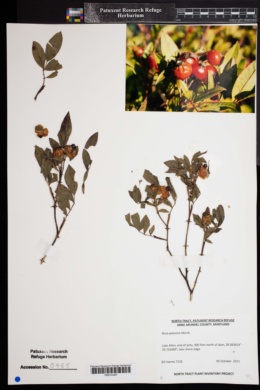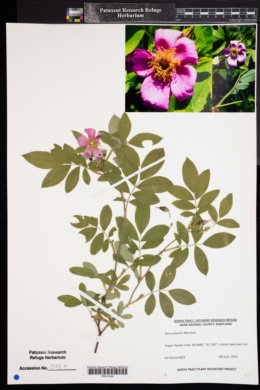Rosa palustris
|
|
|
|
Family: Rosaceae
Swamp Rose
[Rosa dasistema Raf., moreRosa elegans Raf., Rosa elongata Rossig ex Steud., Rosa enneaphylla Raf., Rosa fragrans Salisb., Rosa glandulosa Raf., Rosa hispidocarpa Chabert, Rosa hudsoniana Thory, Rosa hudsoniana var. salicifolia Thory, Rosa nuttalliana (Rehder) C. Schneid., Rosa palustris f. inermis (Regel) W. H. Lewis, Rosa palustris var. aculeata (Schuette) Erlanson, Rosa palustris var. sepalorelevata (Schuette) Erlanson, Rosa pensylvanica Michx., Rosa sprengeliana Tratt.] |
Shrub to 2.5 m tall Stem: upright, slender, highly branched, sometimes reddish, to 1.2 cm thick at base, with prickles on lower part of stem. The prickles beneath the stipules are 2 - 10 mm long, stout-based, awl-shaped, recurved or contracted at base, and hard. Leaves: pinnately compound, stalked, main axis (rachis) softly hairy, with five to nine (usually seven) leaflets. The leaflets are dull green, 2 - 6 cm long, narrow elliptic to narrow egg-shaped with tapered to blunt ends, and have softly hairy veins beneath. The more than fifteen teeth per side usually less than 2 mm wide and about 0.5 mm high. Flowers: borne solitary or in a small nearly flat-topped cluster (corymb), 4 - 5.5 cm across, with a stalked-glandular stalk and floral tube (hypanthium), non-persistent spreading to reflexed sepals, and pink petals 2 - 3 cm long. Fruit: bony achenes surrounded by the mature floral tube (hip). The hip is red, 7 - 12 mm across, depressed-spherical to elliptic, and glandular-hairy to hairless. Achenes light brown, 2.5 - 3.5 mm long, 1.5 - 2 mm wide, nearly wedge-shaped and inversely egg-shaped. Stipules: subtending leaves, very narrow and slightly widended at tip, rolling inward, firm. Similar species: Rosa carolina, Rosa palustris, and Rosa virginiana all have non-persistent sepals and stalked-glandular flower stalks and floral tubes. Rosa carolina differs by having straight and slender prickles, flat stipules, and usually five dull to slightly shiny leaflets with fewer than fifteen teeth per side. It is also a low shrub of dry habitats. Rosa virginiana has slender and straight bristles as well as stout and curved prickles, flat stipules, and usually seven to nine shiny and coarsely toothed leaflets. Flowering: late June to early August Habitat and ecology: Frequent on moist bog areas, swamp borders, and disturbed or ditched areas of cranberry bogs. Occurence in the Chicago region: native Etymology: Rosa is the Latin name for a rose. Palustris means marsh-loving. Author: The Morton Arboretum Much-branched shrub to 2 m; infrastipular prickles stout, decurved, 3-6 mm, the flattened base at least half as long; internodal prickles none; stipules very narrow, scarcely widened distally; lf-rachis softly pubescent; lfls commonly 7, narrowly elliptic to oblanceolate, softly pubescent on the midrib beneath, finely serrate, the teeth usually less than 2 mm wide and avg 0.5 mm high; fls solitary or in small corymbs; pedicel and hypanthium stipitate-glandular; sep soon spreading or reflexed, then deciduous; pet pink, 2-3 cm; hips red, only 7-l2 mm thick; 2n=14. Swamps, marshes, and streambanks; N.S. to Minn., s. to the Gulf of Mexico. Evidently hybridizes with R. blanda, and probably to a lesser extent with R. carolina. Gleason, Henry A. & Cronquist, Arthur J. 1991. Manual of vascular plants of northeastern United States and adjacent Canada. lxxv + 910 pp. ©The New York Botanical Garden. All rights reserved. Used by permission. From Flora of Indiana (1940) by Charles C. Deam This species is frequent to infrequent throughout the state, being more common in the lake area. It grows in wet places about lakes, on the borders of swamps in woodland, and along low roadsides. …… Indiana Coefficient of Conservatism: C = 5 Wetland Indicator Status: OBL |
|
|
|

































































